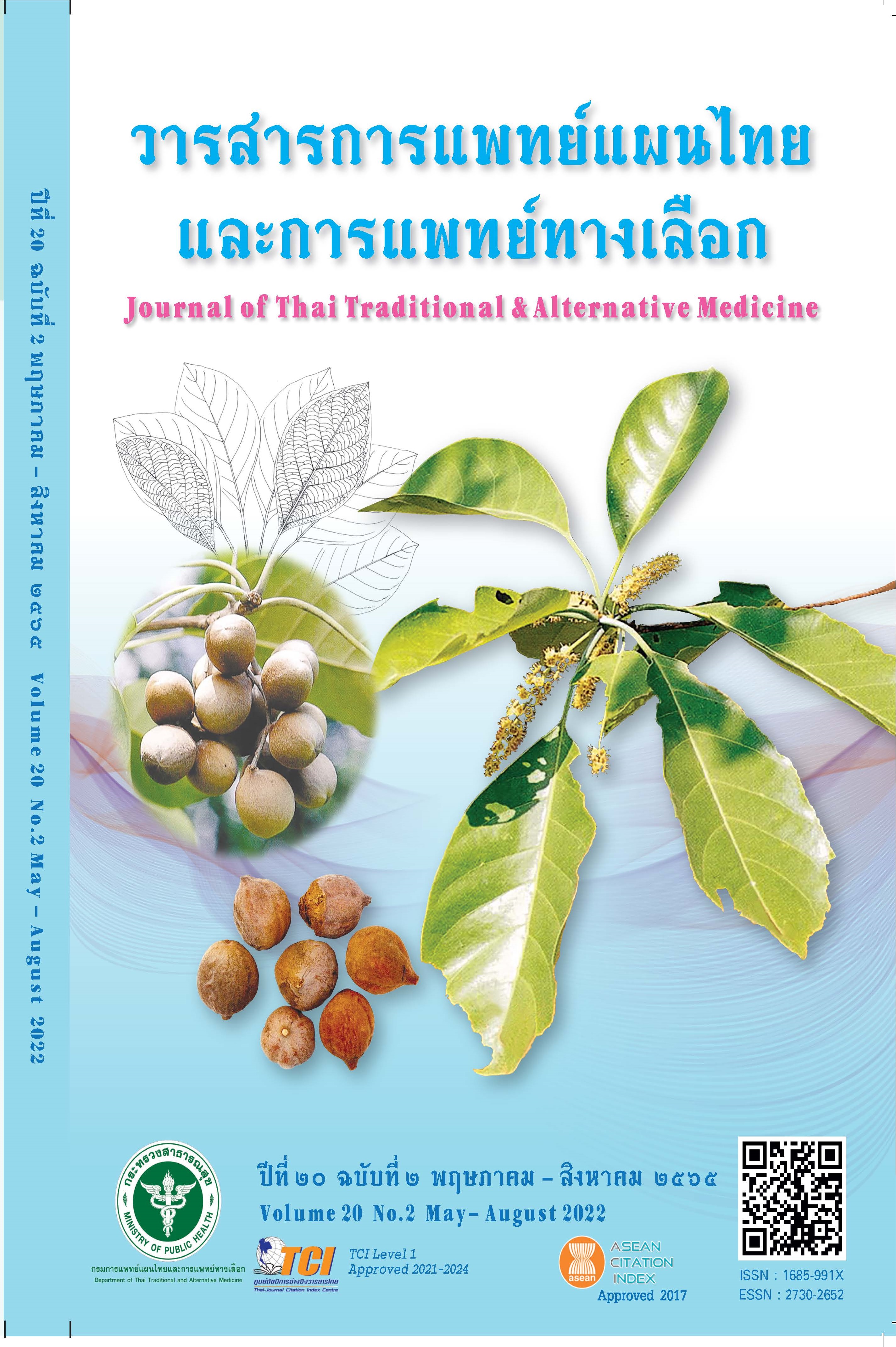Effects of Herbal Lactagogue Remedy (Por Khao Chiab-Laem’s Formula) in Postpartum Women: An Open-Label Placebo-Controlled Clinical Trial
Main Article Content
Abstract
The herbal lactagogue decoction formula of Por Khao Chiablaem, a well-respected local folk healer, has been used in postpartum women at Nong Song Hong Hospital, Khon Kaen province, since 2013. To establish clinical evidence on its efficacy, the effects of this herbal formula on milk flow score, volume of one-hour milk production, uterine fundal height, and lochial discharge were studied. The open-label, placebo-controlled trial was conducted in two groups of postpartum women at Nong Song Hong and Waeng Noi Hospitals as treatment group and control group, respectively. The treatment group was given the lactagogue decoction at the dose of 4 L/day for 10 days (the first dose was given right after the delivery), while the control group took the same dose of warm water. It was found that the cumulative number of participants who had milk flow score of 4 in the test group was higher than that in the control group from 3 to 36 hours postpartum. At the 36th hour, the cumulative number of such participants was 24/36 (66.7%) in the test group vs 13/36 (36.1%) in the control group (p = 0.009). The volume of milk production in one hour at 48 hours postpartum was 16.48±15.37 mL in the test group, compared to 10.06 ± 9.31 mL in the control group (p = 0.037). On day 14 postpartum, the test group had significantly lower uterine fundal height (1.50 ± 2.52 cm) than the control group (3.97 ± 3.88 cm) (p = 0.003). Meanwhile, the amount of lochial discharge and the time for the change of lochia color from blood red to yellow were not different between the two groups. In conclusion, this study shows that herbal lactagogue remedy (Por Khao Chiablaem’s formula) can promote early milk flow and increase milk production at 48 hours postpartum, as well as promote uterine involution, while not affecting lochial discharge.
Article Details

This work is licensed under a Creative Commons Attribution-NonCommercial-NoDerivatives 4.0 International License.
References
World Health Organization [Internet]. Geneva: The Organization; c2021 [cited 2021 Aug 9]. Breastfeeding; [about 3 screens]. Available from: https://www.who.int/health-topics/breastfeeding
Walsh D. A review of evidence around postnatal care and breastfeeding. Obstet Gynaecol Reprod Med. 2011; 21(12): 346-50.
Hale TW, Kendall-Tackett K. Domperidone versus metoclopramide: Self-reported side effects in a large sample of breastfeeding mothers who used these medications to increase milk production. Clinical Lactation. 2018;9(1):10–7.
Drugs and Lactation Database (LactMed) [Internet]. Bethesda (MD): National Library of Medicine (US); c2006-. Metoclopramide. [updated 2021 Jul 19; cited 2021 Aug 9]. Available from: https://www.ncbi.nlm.nih.gov/books/NBK501352/
Yanase Y. Utilization of galactogogues to induce lactation and increase breast milk production. Obstetric and Gynaecological bulletin. 2013;12(2):1-5. (in Thai)
Meepradit K. Effect of postpartum herbal of Kab Choeng hospital, Surin province (thesis). Nakhon Pathom: Silpakorn University; 2011. (in Thai)
Kwasan S. Effectiveness comparison of domperidone and galactagogue on breast milk production in postpartum women. Nakhonphanom Hospital Journal. 2014;1(2):55-64. (in Thai)
Pinthong P. Compilation of Isan ancient medicinal formulae. Ubon Ratchathani: Siritham Offset; 1992. (in Thai)
Paritakul P, Ruangrongmorakot K, Laosooksathit W, Suksamarnwong M, Puapornpong P. The effect of ginger on breast milk volume in the early postpartum period: A randomized, double-blind controlled trial. Breastfeeding Medicine. 2016;11:361-5. doi: 10.1089/bfm.2016.0073.
Lawrence RA, Lawrence RM. Breastfeeding: A Guide for the Medical Profession. 6th ed. St Louis, MO: Mosby; 2005.
Hibberd CM, Brooke OG, Carter ND, Haug M, Harzer G. Variation in the composition of breast milk during the first 5 weeks of lactation: implications for the feeding of preterm infants. Arch Dis Child. 1982;57:658–62.
Phongboonrod S. Mai Thet Mueang Thai. Bangkok: Kasem Bannakij; 1979. (in Thai)
Buncharoen W, Saenphet K, Saenphet S, Thitaram C. Uvaria rufa Blume attenuates benign prostatic hyperplasia via inhibiting 5-reductase and enhancing antioxidant status. J Ethnopharmacol. 2016;194:483-94.
Bayram F, Müderris II, Güven M, Keleştimur F. Comparison of high-dose finasteride (5 mg/day) versus low-dose finasteride (2.5 mg/day) in the treatment of hirsutism. European Journal of Endocrinology. 2002;147:467-71. Doi: 10.1530/eje.0.1470467.
Fonseca ME, Cruz ML, Loustaunau E, Ochoa R, Hernandez M, Zárate A. Estrogen replacement therapy increases prolactin levels in postmenopausal women. Menopause: The Journal of The North American Menopause Society. 1997;4(4):201-5.
Voogt JL. Control of hormone release during lactation. Clin Obstet Gynaecol. 1978;5(2):435-55.
Beesley RD, Johnson JV. The breast during pregnancy and lactation. Glob. Libr. Women’s med., (ISSN: 1756-2228). 2008. Doi: 10.3843/GLOWM.10305.
Chen CL, Meites J. Effect of estrogen and progesterone on serum and pituitary prolactin levels in ovariectomized rats. Endocrinology. 1970;86(3):503-5. Doi: 10.1210/endo-86-3-503.
Goh HH, Ratnam SS. Effect of estrogens on prolactin secretion in transsexual subjects. Arch Sex Behav. 1990;19:507-16. Doi: 10.1007/BF02442351.
Narendran R, Hacker RR, Smith VG, Lun A. Hormonal induction of lactation: estrogen and progesterone in milk. J Dairy Sci. 1979;62:1069-75.
Frei S, Kurmanavicius J, Zimmermann R, Mandach UV. Puerperal symphysis fundus distance: normal values. J Perinat Med. 2010;38:173-7.
Macabeo APG, Tudla FA, Krohn K, Franzblau SG. Antitubercular activity of the semi-polar extractives of Uvaria rufa. Asian Pac J Trop Med. 2012;5(10):777-80.
School of Thai traditional medicine, Wat Phra Che Tu Phon Wimon Mang Khla Ram. Compilation of Thai herbal medicine indication (Vol. I). Bangkok: Bo-phith Printing; 1994. (in Thai)
Bhanumathy M, Chandrasekar SB, Chandur U, Somasundaram T. Phyto-pharmacology of Celastrus paniculatus: An overview. International Journal of Pharmaceutical Sciences and Drug Research. 2010;2(3):176-81.


